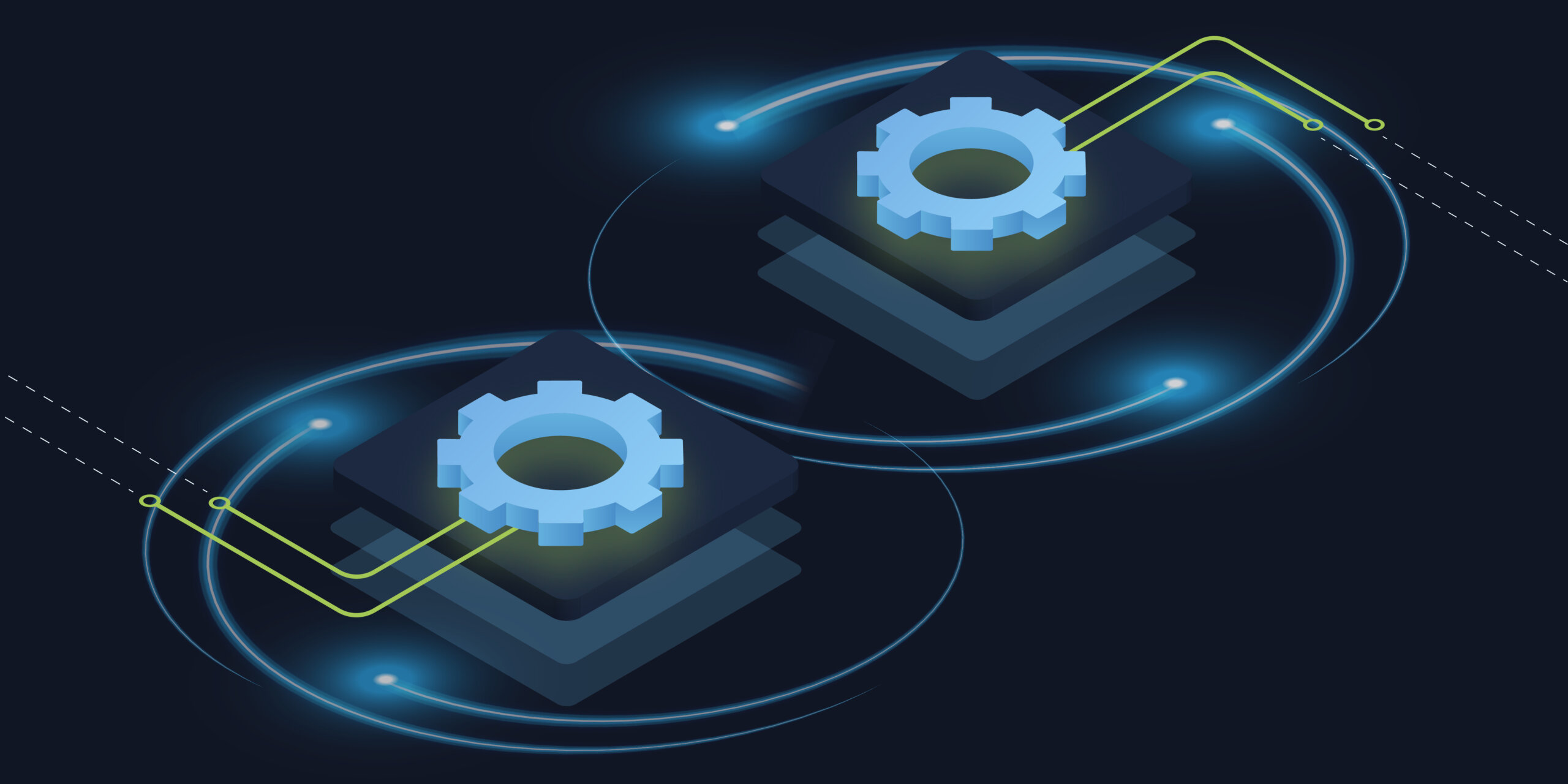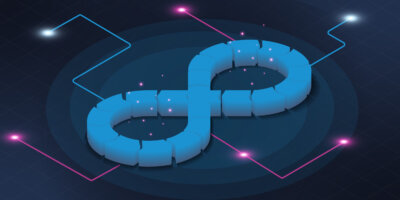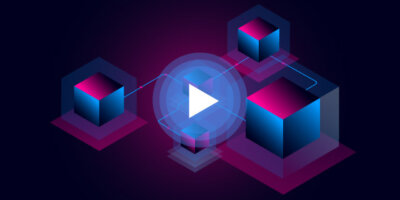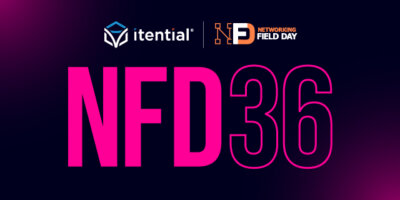Integrations are the building blocks of network automation success.
Think about your organization’s network and cloud infrastructure. You have multiple network domains, different systems like IPAM and monitoring, devices and controllers and cloud-based services from a variety of different vendors. To automate effectively, you need to be able to integrate with all of it.
But many network and cloud automation solutions out there limit your options. You might have a network automation platform where the vendor charges you per integration because they’re building each one from scratch. Or you could be in a situation where all the responsibility for building and maintaining integrations falls entirely on your organization. In these kinds of scenarios, attaining access to integrations will cost you and your organization time, money, or both.
All these barriers make network processes less efficient, and they can influence network leaders away from adopting useful technologies because of the cost of building out the required integrations. Itential’s integrate-with-anything approach offers another way. Our software leverages modern API standards and JSON to provide powerful auto-generation capabilities so you can instantly integrate with your systems (for free!). And you can also onboard all of your CLI or other automation assets like Ansible Playbooks and Terraform Plans and attach APIs to them, allowing you to leverage them in larger automation workflows.
At the most recent Networking Field Day (NFD) event earlier this year, Rich Martin, our Director of Technical Marketing and a network engineer for over 25 years, gave a presentation and demo that detailed how integrating network automations with your IT infrastructure for both NetOps teams and DevOps teams makes end-to-end automation possible. With Itential’s robust integration capabilities, both sets of teams are able to take the best toolsets, methods, and skillsets from each other and move toward the more effective NetDevOps approach.
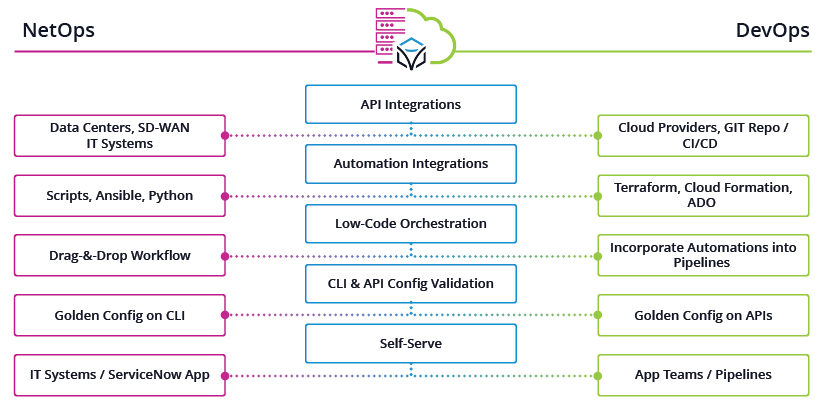
You can find the full presentation here, or keep reading to get an overview and some key takeaways.
Integrating with API-Based Systems
Today, most tools and systems that organizations adopt for their networks provide publicly accessible APIs, and more and more of those use the Swagger/OpenAPI specification. That’s a level of standardized connectivity that was unheard of in networking until recently, and it’s an opportunity for network teams to evolve. Itential is built for this API-driven ecosystem, providing new options for both NetOps and DevOps teams to automate.
Itential’s Solution:
Itential users can leverage the Itential Adapter Builder to auto-generate a connection based on API documentation. Any system that provides API documentation in the Swagger/OpenAPI specification or a Postman collection can be used to auto-generate an integration which allows the system to be incorporated into an end-to-end change process workflow.
For systems that do not provide standardized API documentation, the Adapter Builder also provides a way to build integrations using form-based inputs, so there’s still no code involved. And on top of that, Itential publishes an open source collection of Pre-Built Integrations here, which you can use for many systems that have non-standard APIs, or just to speed things up while you’re building automations. Using Itential, you can seamlessly orchestrate workflows across every API-based system your organization uses.
Example API Resources For NetOps Teams:
- Data center controllers, SD-WAN controllers.
- IT systems such as IPAM, ITSM/CMDB.
Example API Resources For DevOps Teams:
- Cloud environments: AWS, Google Cloud, Azure, and others.
- Key tooling like GitHub or BitBucket.
Itential provides a unified way for teams to build automations that incorporate any changes, inputs, or outputs from API-enabled network and IT systems, giving network teams the tools to make the most of the modern networking environment.
Onboarding Non-API Resources (CLI, SSH, NETCONF, GNMI, etc.)
While charging ahead to fit an API-first world is all well and good, there’s the other half of things to consider: tooling and assets that are based in CLI, SSH, NETCONF, GNMI, or similar. For example, many network teams today build automation scripts for individual tasks using Python or Ansible, and many cloud teams use tooling like Terraform and Azure DevOps for the same. It’s important to be able to leverage these kinds of assets in your larger workflows to get the most out of automation.
Itential’s Solution:
A standalone application called Itential Automation Gateway provides all of the different sets of capabilities needed for onboarding script-based assets, attaching APIs to them, and normalizing them for use in a drag-and-drop workflow. This application allows teams to continue using the automation tooling they are familiar with, even after taking a platform approach to network automation. Further, it extends the value and lifespan of each script or similar asset. What had previously been built for one task, by one user, is now presented in an organization-wide directory for reuse in future workflows, so that there isn’t any repeated work if a certain task must be executed across multiple workflows. Or, put in simpler terms: NetOps and DevOps teams alike can stop repeating the same work over and over.
Example Non-API Resources For NetOps Teams:
- Python scripts, Ansible Playbooks.
- Custom or vendor-specific command-line tooling for network systems.
Example Non-API Resources For DevOps Teams:
- Terraform Plans.
- Java, JavaScript, and other programs.
These scripts or similar assets are useful, but they are also limited — alone, they can only take you so far, and one person’s script might never leave their machine. The ability to plug these assets into larger workflows solves a couple problems. It helps users share and reuse what is being built, allows practitioners to continue using tooling they’re comfortable with, and provides the ability to automate CLI and API resources right alongside each other. Let’s get into what that means for you.
Putting it All Together: Leveraging Normalized Assets to Build Automations
By putting all the pieces together, you get a network automation platform that serves as your central hub for all network and cloud infrastructure, plus the IT systems that they need to connect with. Instead of automating single tasks and swivel-chairing to external systems to make manual changes, you can orchestrate an entire change process end-to-end, whether it would require zero integrations or a hundred.
The big word here is flexibility. Flexibility from a technology standpoint and from a business standpoint. On the tech side, you have the flexibility to always choose the right tool for the right job, adopting technology to fit network and cloud needs without hesitating due to custom or slow integration work. On the business side, you get to free yourself from vendor lock-in. An automation platform that integrates with everything lets you adopt new vendors with ease, retool your infrastructure to accommodate new vendors, and even use different vendors for similar purposes across different locations, use cases, or otherwise.
Then, looking ahead, a robust approach to integrations is how organizations get to the point where they achieve zero-touch automation. Itential’s integration model makes network automation easier for everyone — both the practitioner and the end user, across both NetOps and DevOps teams.
Learn more about how this works in Rich’s on-demand session from NFD here.

